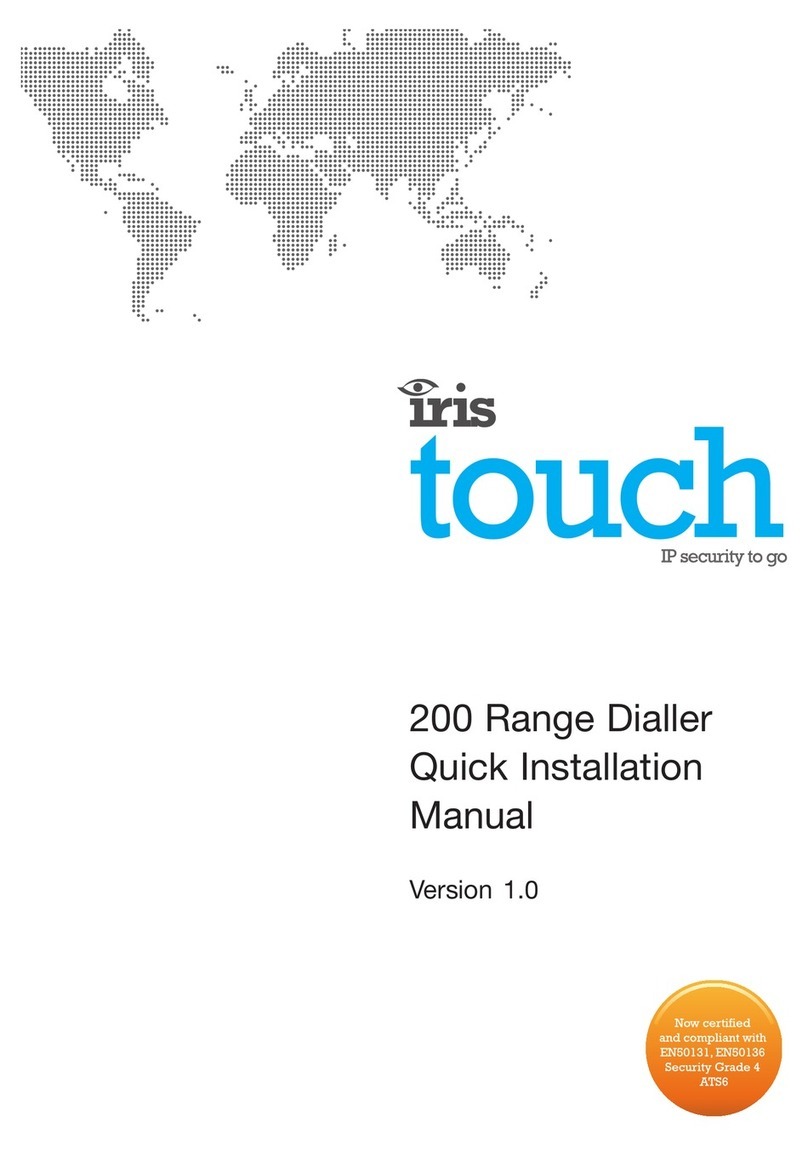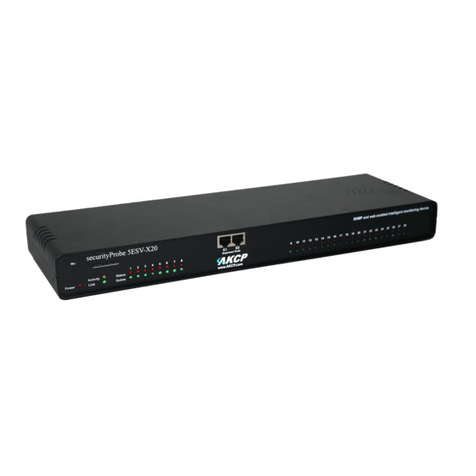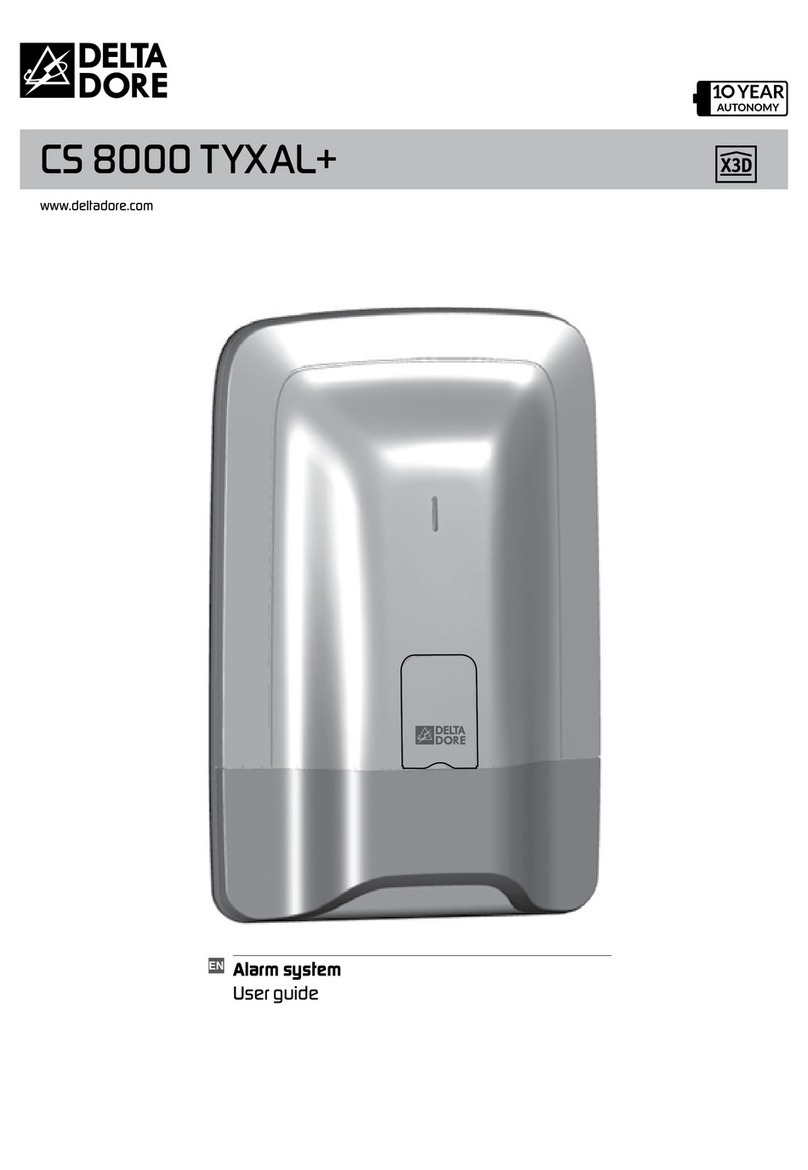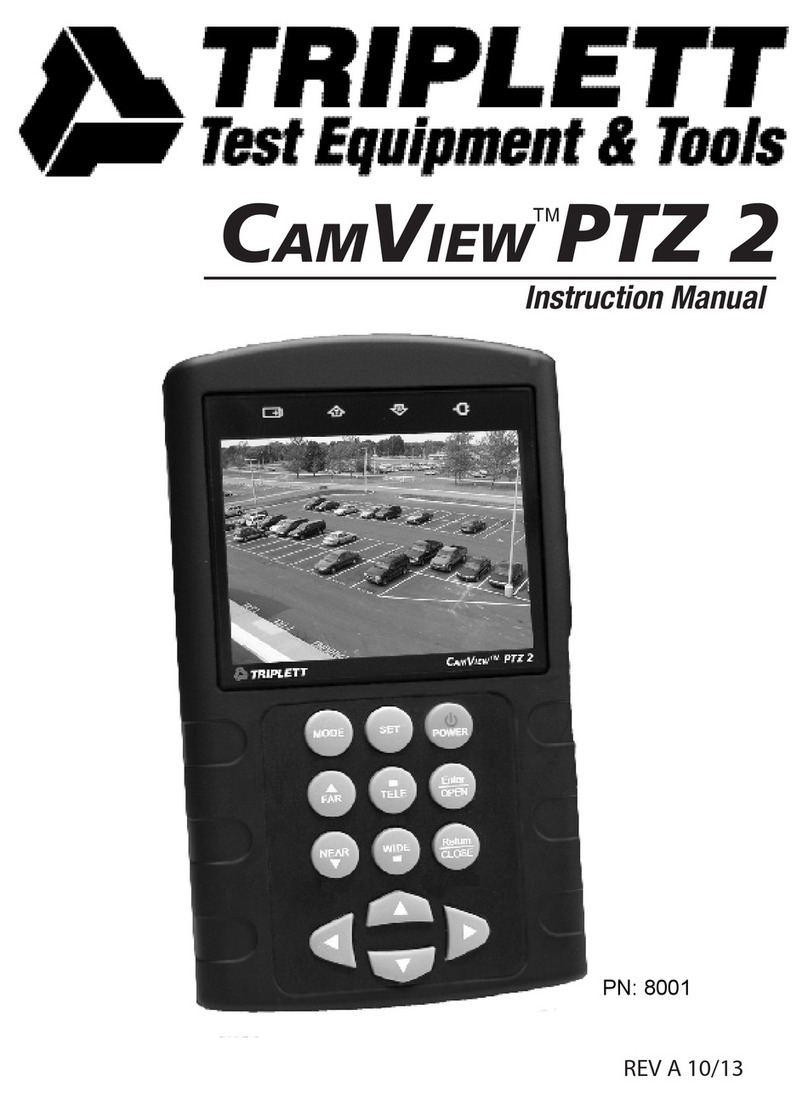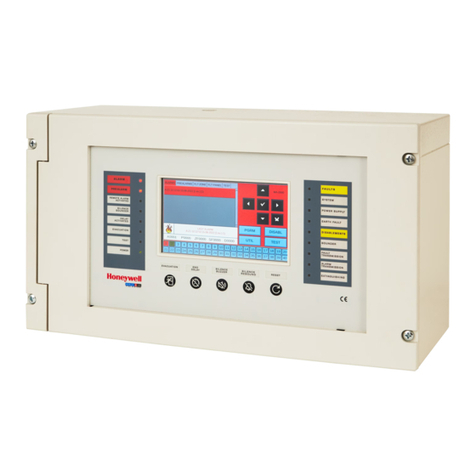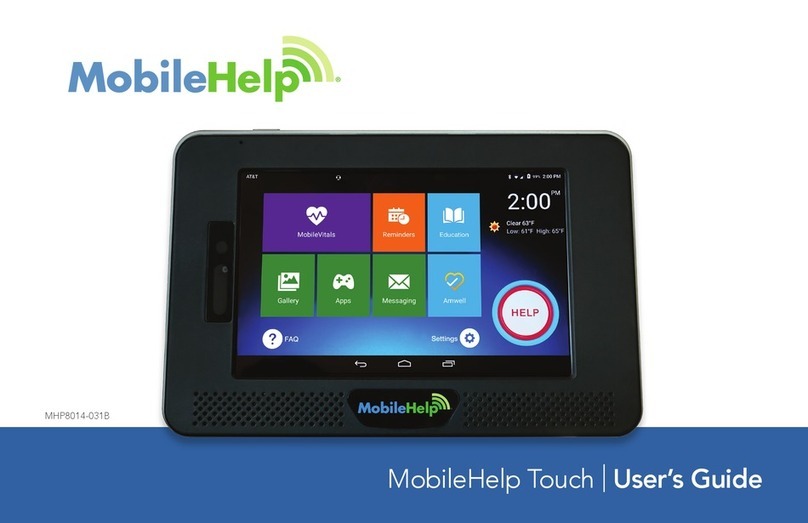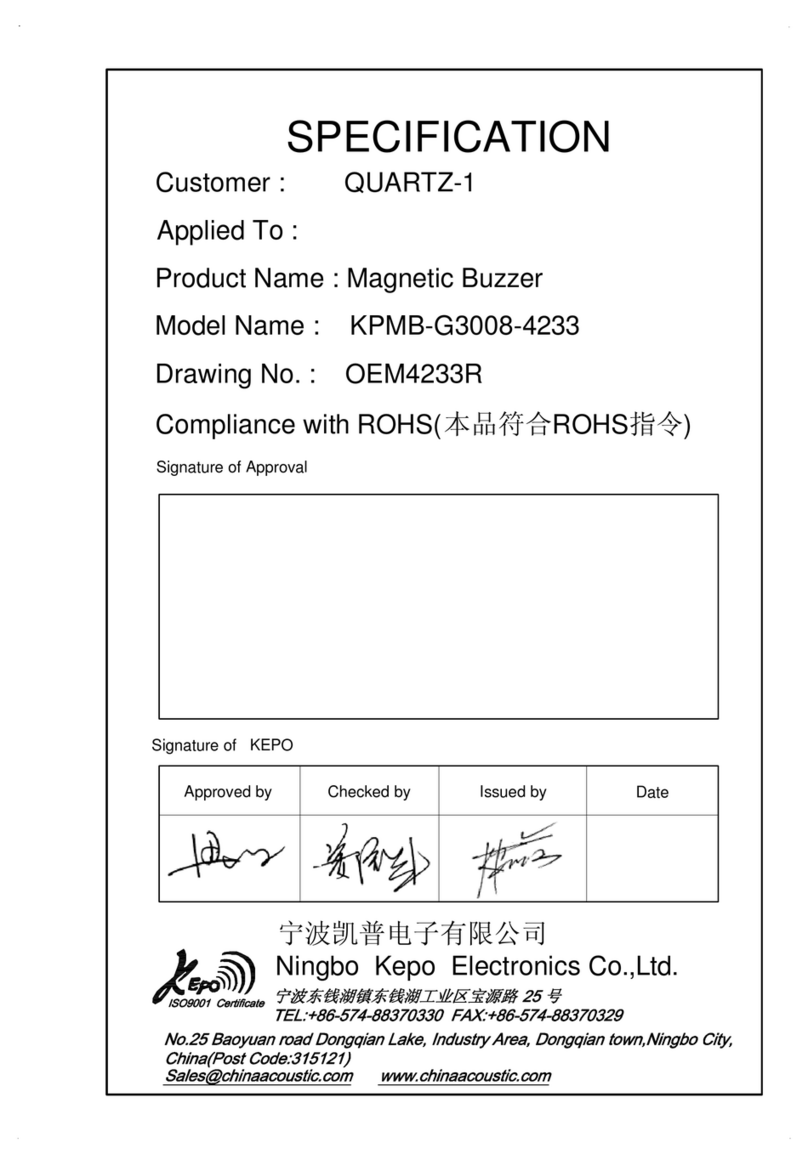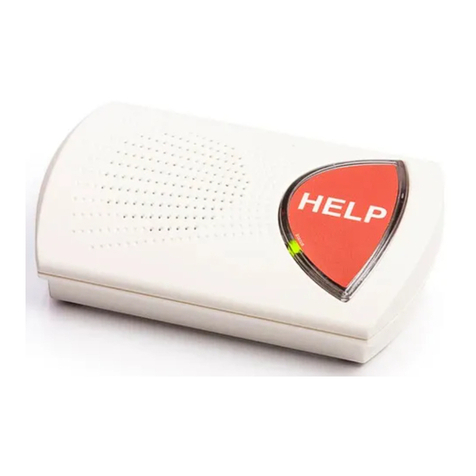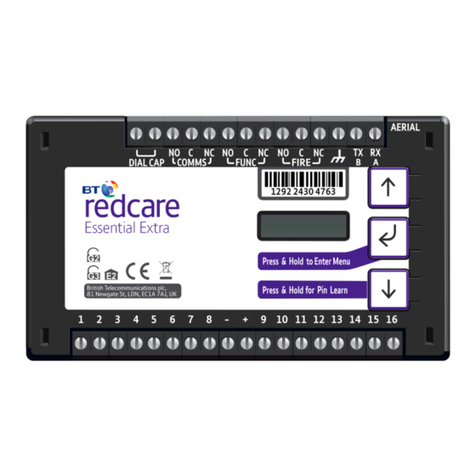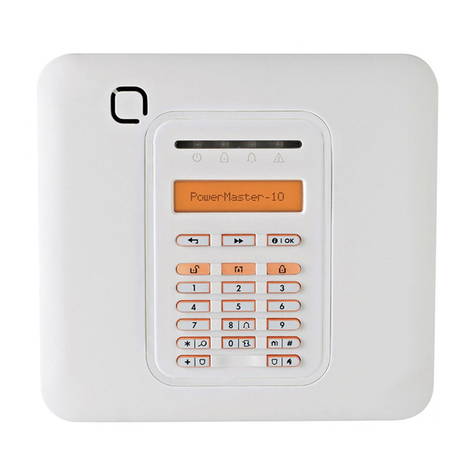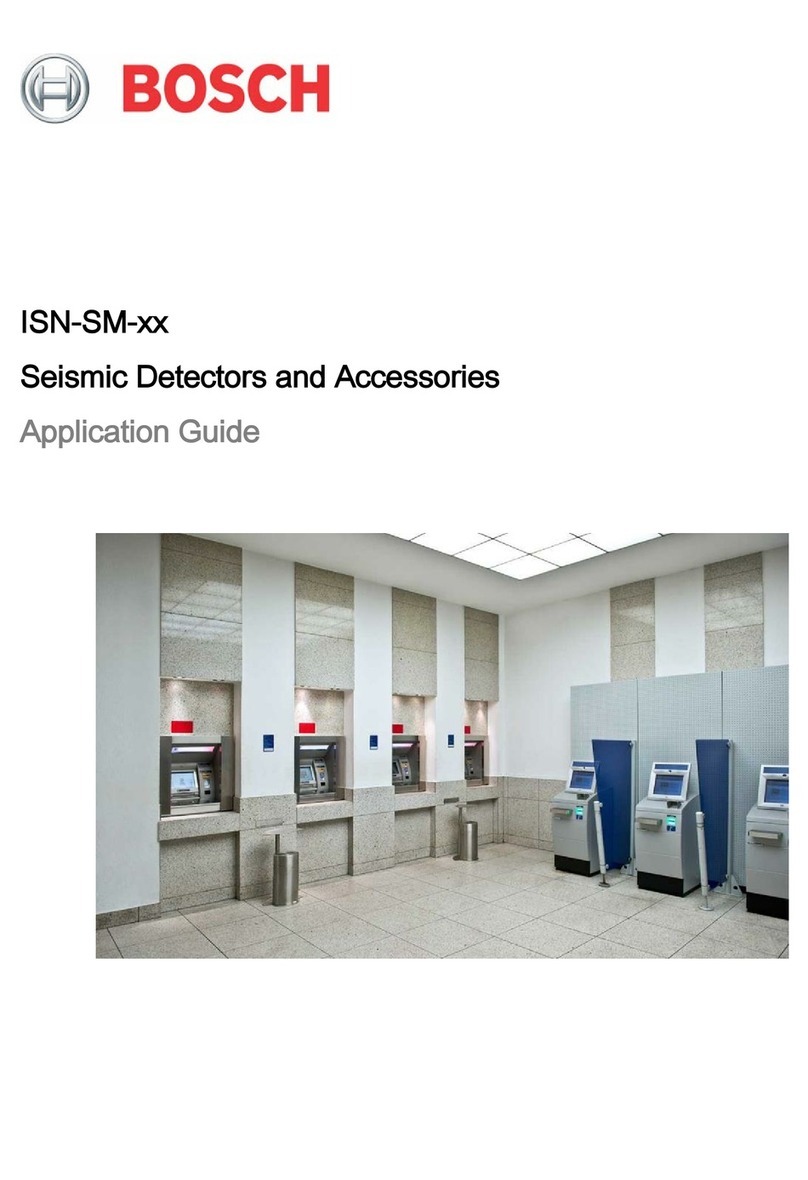Chiron Technology IRIS 8xx Series User manual

Chiron Technology
IRIS 8xx Series Alarm over IP Dialler
Installation and User Guide
Chiron Technology
Wyvols Court
Swallowfield
Reading
UK
Tel: +44 (0)118 988 0228
E-mail: [email protected]
Chiron Technology Ltd 2006
Version 1.5 16/10/06
The information contained is supplied without liability for any errors or omissions. No part may be reproduced or used except as
authorised by contract or other written permission. The copyright and foregoing restriction on reproduction and use extend to all
media in which the information may be embedded.

Table of Contents
1OVERVIEW 7
2PRODUCT INVENTORY 8
3INTERFACES AND INDICATORS 9
3.1 IRIS 800 9
3.1.1 PCB Unit – Front Panel Indicators 9
3.1.2 PCB Unit – Rear Panel Connectors 9
3.1.3 Cased Unit – Front Panel Indicators 9
3.1.4 Cased Unit – Rear Panel Indicators 9
3.2 IRIS 820 10
3.2.1 PCB Unit – Front Panel Indicators 10
3.2.2 PCB Unit – Rear Panel Connectors 10
3.2.3 Cased Unit – Front Panel Indicators 10
3.2.4 Cased Unit – Rear Panel Connectors 10
3.3 IRIS 840 11
3.4 IRIS 850 12
3.4.1 PCB Unit – Front Panel Indicators and Connector 12
3.4.2 PCB Unit – Rear Panel Connectors 12
3.4.3 PCB Unit – Pin Inputs and Relay Outputs 12
4INSTALLATION – ALARM TRANSMISSION AND POLLING OVER IP 14
4.1 Preparation Prior to Installation 14
4.2 Physical Installation 14
4.3 Checking Network Connection 15
4.4 Polling Configuration 16
4.5 Alarm Transmission Configuration 17
5INSTALLATION – BACKUP TRANSMISSION OVER PSTN OR ISDN 18
5.1 Preparation Prior to Installation 18
5.2 Physical Installation 18
5.3 Checking Network Connection 18
5.4 Alarm Transmission Configuration 18
6INSTALLATION – BACKUP POLLING/TRANSMISSION OVER GPRS 20
Version 1.5 16/10/06 2

6.1 Preparation Prior to Installation 20
6.2 Physical Installation 20
6.3 Checking and Network Connection 20
6.4 Polling Configuration 21
6.5 Alarm Transmission 21
7INSTALLATION – BACKUP TRANSMISSION OVER GSM 22
7.1 Preparation Prior to Installation 22
7.2 Physical Installation and Checking Network Connection 22
7.3 Alarm Transmission 22
8ADVANCED INSTALLATION - DATA CALLS 23
8.1 Installation 23
8.2 Configuration 24
8.2.1 General 24
8.2.2 Calls over ISDN using V.120 Rate Adaption 24
8.2.3 Calls over Ethernet using TCP/IP 24
8.2.4 Calls over GPRS using TCP/IP 25
9ADVANCED INSTALLATION – PIN ALARMS 26
9.1 Installation 26
9.2 Default Alarm Messages 27
9.3 Configuration 27
10 ADVANCED INSTALLATION - SMS MESSAGING 29
10.1 Installation 29
10.2 Configuration 29
11 ALARM PANEL UPLOAD AND DOWNLOAD 31
12 LOCAL CONFIGURATION SOFTWARE 32
12.1 Installation of the Local Configuration Software 32
12.2 Connecting to the Dialler 32
Version 1.5 16/10/06 3

12.3 Running the Configuration Software 32
13 LOCAL CONFIGURATION WITH A TELEPHONE HANDSET 33
13.1 Dialler Default 33
13.2 IP Address 33
14 TROUBLESHOOTING 34
15 SPECIFICATION 35
15.1 Feature comparison 35
15.2 Polling over IP 36
15.3 Alarms over IP 36
15.4 Alarm and Polling Security 36
15.5 Alarm System Upload/Download 36
15.6 Alarm Interface 37
15.7 Ethernet Interface 37
15.8 ISDN Interface 37
15.9 PSTN Interface 37
15.10 GSM/GPRS Interface 38
15.11 SMS Messaging 38
15.12 Data Interface 38
15.13 Pin Inputs 38
15.14 Relay Outputs 38
15.15 LED Status Indicators 40
15.16 Power Supply 40
15.17 Weights 40
16 CONFORMANCE AND SAFETY 41
16.1 Conformance 41
16.2 Conformance to EN50131 and EN50136 41
Version 1.5 16/10/06 4

16.3 Safety 42
Version 1.5 16/10/06 5

Change History
Revision Date Changes
1.5 16/10/08 Added clarifications for EMC conformance
1.4 5/9/06 Added info on time for detection and reporting of alarms
and faults on alarm dialler and pin inputs.
Added details on serial interface data stop/parity/bits.
Changed analogue POTS voltage value to 40V peak.
Removed pin input sense resistors from inventory.
1.3 22/5/06 Requirement to install in suitable enclosure is now
mandatory rather than recommended.
1.2 25/1/06 Added IRIS 840.
1.1 29/12/05 Replace references to Velcro to self-adhesive feet.
Included sense resistors in inventory.
Change references to IRIS Configuration Console to IRIS
Configuration Software.
Added details for pin alarms.
Added product weights to spec section.
0.7 Original production version.
Version 1.5 16/10/06 6

1 Overview
The Chiron IRIS Alarm over IP Dialler range offers a unique way to connect any
standard alarm dialler over an IP network, with backup over traditional PSTN or
ISDN dial-up networks and/or GSM/GPRS wireless networks if required.
An integral polling mechanism is included in all products to provide constant
monitoring of the communications paths so that any problems are reported to the
ARC.
Advanced features such as data calls and SMS messaging are also offered.
The full set of features of each model in the range is included in the Specification
section at the end of this User Guide.
The Installation sections of this Use Guide sets out a straightforward set of
instructions for the installer from the most simple installation for alarm
transmission over an IP network, through installations with communications
backup routes, to more advanced installations which use data call and SMS
messaging features of the IRIS range.
Version 1.5 16/10/06 7

2 Product Inventory
The accessories included with each IRIS unit are as follows:
IRIS
800
(PCB)
IRIS
800
(Cased)
IRIS
820
(PCB)
IRIS
820
(Cased)
IRIS
840
(PCB)
IRIS
850
(PCB)
Main IRIS unit ••••••
Plug top mains power
supply
••
Power cable ••••
Ethernet cable (cream) ••••••
Dialler cable (grey) ••••••
ISDN cable (black) •••
PSTN cable (grey) •••
Installation guide ••••••
18K sense resistor ••••••
Antenna Optional Optional
When using the Local Configuration Software, a standard 9-way modem serial
cable is required for connection of the IRIS Dialler to a lap-top.
For the IRIS 840 and 850, the GSM SIM card can be obtained from the chosen
GSM network operator. Note that a SIM card offering both GSM and GPRS calls
is required to enable the full functionality.
Version 1.5 16/10/06 8

3 Interfaces and Indicators
The interface and indicators on each unit are shown below. Please see the
Installation sections for more details on how these are used.
3.1 IRIS 800
Note – for the IRIS 800 the PCB version is narrower than the cased version.
3.1.1 PCB Unit – Front Panel Indicators
DIAL
ETH
POLL
PWR ETH
3.1.2 PCB Unit – Rear Panel Connectors
DIAL V24
3.1.3 Cased Unit – Front Panel Indicators
Alarm Adapter
IRIS 800
DIAL SDETH POLL RD TR
3.1.4 Cased Unit – Rear Panel Indicators
ETHV24DIALPWR
Version 1.5 16/10/06 9

3.2 IRIS 820
3.2.1 PCB Unit – Front Panel Indicators
PSTN DIAL ETH POLL RD SD TR ISDN
3.2.2 PCB Unit – Rear Panel Connectors
PWR V24 ETH ISDN
PSTN DIAL
3.2.3 Cased Unit – Front Panel Indicators
Alarm Adapter
PSTN
IRIS 820
DIAL SDETH POLL RD TR ISDN
3.2.4 Cased Unit – Rear Panel Connectors
ISDNETHV24DIALPWR PSTN
Version 1.5 16/10/06 10

3.3 IRIS 840
PCB Unit – Indicators and Connectors
V24
DIAL
PWR
DIALGSM POLL L
A
N
DTRSDRD
PWR
OUT C & D
OUT A & B
INPUTS 1 - 8
REF GND
ANT
ETH
Version 1.5 16/10/06 11

3.4 IRIS 850
3.4.1 PCB Unit – Front Panel Indicators and Connector
ANT PSTN DIAL ETH POLL GSM RD SD TR ISDN
3.4.2 PCB Unit – Rear Panel Connectors
PWR PSTN DIAL V24 ETH ISDN
3.4.3 PCB Unit – Pin Inputs and Relay Outputs
OUT A & B OUT C & D REF GND INPUTS 1 - 8 PWR
Version 1.5 16/10/06 12

The function of each indicator is shown in the table below.
Name
Function
PSTN PSTN network connection status.
DIAL Alarm dialler interface status
ETH Ethernet connection status
POLL Polling status
GSM GSM/GPRS connection status
RD Data transmitted on serial port
SD Data received on serial port
TR Serial port connected
ISDN ISDN network connection status
The function of each connector is shown in the table below:
Name
Function
PWR Power in
PSTN PSTN network connection
DIAL Alarm dialler connection
V24 Serial data port
ETH Ethernet connection
ISDN ISDN network connection
SD GSM/GPRS antenna connection
OUT Relay outputs
INPUTS Pin inputs for generating alarm or SMS messages
REF GND 0V reference for inputs
Version 1.5 16/10/06 13

4 Installation – Alarm Transmission and Polling over IP
The standard method for linking an alarm panel to an IRIS Dialler is by connecting
the alarm panel dialler 2-wire (telephone) output to the IRIS Dialler. The installation
procedure for this type of installation is described in this section.
For IRIS Diallers with pin inputs, these pins can also be used as an additional, or
alternative way to connect to the alarm panel or other alarm sources. The procedure
for this type of installation is described in the Advanced Installation – Pin Alarms
section below.
4.1 Preparation Prior to Installation
1. Check that the ARC to which connection is to be made supports Chiron’s IRIS
Alarm over IP system.
2. The IP address of the Polling Engine/Receiver at the ARC is required – this
will be a twelve digit number. Note – IP addresses are often provided as four
numbers separated by the “.” character, e.g. 192.168.3.34. This will need to
be converted to a twelve digit equivalent by adding leading zeroes to each
number to make them up to three digits each, and then removing the “.”s. The
address above becomes 192168003034.
3. The account (“chip”) number is loaded into the alarm dialler – this is the same
as required for any standard dialler installation.
4. The IRIS Dialler should be set to factory defaults. If it is believed that the
Dialler has been used before on another site and retains that configuration, it
should be set to defaults. The way to do this is describer in the Local
Configuration sections of the User Guide.
5. The IRIS Dialler has an Ethernet interface for IP network connection that uses
Automatic IP addressing (sometimes referred to as DHCP). If Fixed IP
addressing is required this can be set up on the IRIS Dialler as described in
the Local Configuration sections of this User Guide.
4.2 Physical Installation
1. It is essential that the IRIS Dialler is located within a standard alarm enclosure
with battery backup and tamper protection to ensure the installation conforms
to the relevant standards for alarm systems and safety. Ideally it is
recommended that this is the same enclosure as the alarm dialler uses so that
no extra battery backed power supply or tamper protection is required.
Locating within the same enclosure as the alarm system also allows direct
wiring to the alarm dialler without any external cabling being needed.
2. Make allowances for the external wiring which will be required, i.e. IP network
connection via the Ethernet cable. Make sure external cable runs are
protected from tampering.
Version 1.5 16/10/06 14

3. If the PCB version of the IRIS Dialler has been selected, use the self adhesive
stand-off feet fitted to the board to mount the Dialler where required.
4. Connect the 2-wire analogue line interface on the alarm dialler to the DIAL
input connector on the Dialler using the cable provided (Grey). This cable is
terminated at both ends with an RJ11 plug and if the dialler has a connector
block rather than an RJ11 socket, the cable can be cut and stripped. The two
centre cores should be used and the polarity of the connection is not
important.
5. The Dialler has the facility to monitor the connection to the alarm dialler so
that it can detect disconnection and report this to the ARC. If this facility is
required, connect an 18K ohm sense resistor across the 2-wire analogue
interface on the alarm dialler.
Note – for this feature to work correctly it is essential that this resistor is
connected at the alarm dialler end of the cable, not the Dialler end.
The ARC must also enable this facility on this Dialler.
6. Use the Ethernet cable provided (Cream) to connect the ETH interface on the
IRIS Dialler to the local router, hub, switch etc that gives access to the IP
network. The cable provided is terminated at both ends with an RJ45 plug that
is the standard interface used for Ethernet connections on most equipment.
Make sure this cable run is protected from tampering.
Note - it is essential that the Cream cable is used rather than the black
(ISDN) cable.
7. Connect the IRIS Dialler to the power source (normally the 12V battery
backed supply in the alarm panel) using the cable provided (white stripe is
negative). The polarity of connections is important for correct operation,
although the Dialler is protected against damage from the application of a
reversed polarity power supply.
8. When the power is connected correctly several LEDs on the Dialler come on
or start flashing.
4.3 Checking Network Connection
1. A short while after applying power (typically about 10s) the Ethernet interface
to the IP network connection can be checked.
2. If this interface is running correctly the ETH LED will be on steady (it may
flicker from time to time indicating data flow).
Version 1.5 16/10/06 15

3. If the ETH LED is flashing on/off on a .5s/.5s cycle, then the Ethernet
connection has not synchronised. This could be for a number of reasons:
• Cable not connected properly.
• Cable connected to wrong device or port on device (e.g. router).
• Device to which cable connected not switched on.
4. If the ETH LED flashes off briefly every 1s, then this indicates that it is
synchronised but has not been given an IP address. The IRIS Dialler may
need to be set with a Fixed IP address (see Local Configuration sections).
Consult the local Network Manager.
4.4 Polling Configuration
1. To start up polling from the IRIS Dialler to the ARC, the Dialler must be loaded
with the IP address of the ARC and the account number of the dialler, both of
which can be loaded into the IRIS Dialler from the dialler.
2. Make sure the alarm dialler is set up with its account number. Set the IP
address of the ARC (i.e. twelve digits) into the ARC telephone number field in
the alarm dialler configuration.
3. Trigger the dialler to transmit an alarm. This dialler going off hook is indicated
by the DIAL indicator on the IRIS Dialler coming on. The IRIS Dialler will now
automatically pick up the account number and IP address from the information
transmitted by the dialler and start the polling process to the ARC.
4. Once the IRIS Dialler has successfully completed a poll to the ARC, the POLL
indicator comes on and remains on until the next poll. The installer can check
that polling is operating correctly by checking that the POLL indicator is on
and flickers off briefly (note – it may be so brief as to be unnoticeable) each
time a poll is made.
5. If the POLL indicator does not come on, this may be because the wrong
account number or ARC IP address have been entered. Set the IRIS Dialler
back to factory defaults, check the account number and IP address loaded
into the dialler and try again.
Alternatively, there could be some IP network connection problem making it
impossible for the IRIS Dialler to communicate with the ARC – consult the
local Network Manager.
6. The installer does not need to provide other parameters required for polling
e.g. polling interval and security key as these are loaded remotely by the ARC
when it receives the first polling call.
7. The configuration is stored by the IRIS Dialler in non-volatile memory and will
be retained even if power is removed.
Version 1.5 16/10/06 16

4.5 Alarm Transmission Configuration
1. The Polling Engine at the ARC also acts as the receiver for alarm signalling. If
the dialler is only required to communicate with a single receiver (i.e. there is
no requirement for a backup receiver or second path) then no other
configuration is required.
2. Every time the dialler makes a call to transmit an alarm, the DIAL indicator on
the IRIS Dialler will come on.
3. If a backup or second path is required, the twelve digit IP address of the
second receiver should be programmed into the second ARC telephone
number field of the dialler.
4. Having set up the alarm transmission as required, it is strongly recommended
that all routes are tested by generating alarm signals. During alarm call testing
a standard PSTN line monitor can be used to listen in to the alarm
communications including ‘handshake’ and ‘kiss-off’ tones to confirm correct
operation.
Version 1.5 16/10/06 17

5 Installation – Backup Transmission over PSTN or ISDN
PSTN or ISDN can be used as a backup for alarm transmission, providing an
alternative route to the ARC.
Polling does not operate over ISDN or PSTN as this would incur high call
charges.
The procedures described in this section are in addition to those described in the
previous installation section.
5.1 Preparation Prior to Installation
1. For backup alarm transmission over a traditional PSTN or ISDN path, the IRIS
Dialler communicates with a standard alarm receiver at the ARC. The
telephone number of this receiver will be required.
5.2 Physical Installation
1. If alarm communication over PSTN is required connect the PSTN interface on
the IRIS Dialler to the PSTN service using the Grey cable provided. This cable
is terminated at both ends with an RJ11 plug and if the PSTN service is
connected via a terminal block or Krone strip, the cable can be cut and
stripped. The centre two cores should be used and the polarity of the
connection is not important.
2. If alarm communication over ISDN is required connect the ISDN network
interface on the IRIS Dialler to the ISDN service using the Black cable
provided. This cable is terminated at both ends with an RJ45 plug and this is
the standard interface for ISDN services.
3. Make sure all cable runs are routed so as the protected against tampering.
5.3 Checking Network Connection
1. If the PSTN connection is connected correctly, then the PSTN LED on the
IRIS Dialler will be steady. If the PSTN LED is flashing in a .5s/.5s cycle, then
the Dialler cannot see the 50V feed from the PSTN line – check the wiring.
2. If the ISDN LED on the IRIS Dialler is steady then the ISDN connection is
synchronised correctly. If the ISDN LED is flashing in a .5s/.5s cycle then
there is some problem with the ISDN network or the cabling.
5.4 Alarm Transmission Configuration
1. To select routing of an alarm transmission over PSTN or ISDN, place an extra
digit “9” in front of the ARC receiver telephone number programmed into the
alarm dialler. This tells the IRIS Dialler that it should route the call over PSTN
or ISDN. Note – this method operates based on the fact that an IP address
Version 1.5 16/10/06 18

only ever starts with a “0”, “1” or “2’. The IRIS Dialler discards the “9” and dials
the call using the subsequent digits.
2. The IRIS Dialler will call over ISDN if this is connected or over PSTN if not.
The installer therefore detects the route required (PSTN or ISDN) just by
plugging in the appropriate cable.
3. Most alarm diallers allow two ARC numbers to be programmed which can be
used in primary/backup mode or for dual path signalling. Various
combinations of routing can therefore be set up, depending on the numbers
entered:
• Primary and secondary routes over IP.
• Primary route over IP and secondary route over dial-up PSTN or ISDN.
• Primary and secondary routes over dial-up PSTN or ISDN.
• Primary route over dial-up PSTN or ISDN and secondary route over IP.
Version 1.5 16/10/06 19

6 Installation – Backup Polling/Transmission over GPRS
GPRS can be used as a backup for polling and alarm transmission over IP
providing an alternative route to the Polling Engine/Receiver at the ARC. Alarm
transmission calls are routed to the same ARC receiver as would be used with
ISDN or PSTN.
The procedures described in this section are in addition to those described in the
previous installation sections.
6.1 Preparation Prior to Installation
1. A SIM card with GPRS support is required from the chosen GSM/GPRS
operator.
2. The operator will also provide what is referred to as an “APN” which is a name
(e.g. “orangeinternet”) of the gateway between the operator’s GPRS network
and the IP network. A User Name and Password may also be required.
These will be loaded into the IRIS Dialler.
6.2 Physical Installation
1. Connect the GSM antenna. Route the cable and fix the antenna so as to be
protected against tampering.
2. Insert the SIM card into the holder in the IRIS Dialler. If the cased version of
the Dialler is being used, the casing can be unscrewed with the four screws
under the self-adhesive feet to give access to the SIM card holder.
Note – the IRIS Dialler must always be disconnected from power when
inserting or removing the SIM card otherwise damage to the SIM card
can result.
6.3 Checking and Network Connection
1. The signal strength of the GSM connection can be examined using the Local
Configuration Software – see section below. The antenna should be
positioned to give best signal strength.
2. Before a GPRS connection can be made, the IRIS Dialler must register with
the GSM network. Until registration is complete, the GSM indicator on the
IRIS Dialler will flash on/off in a .5s/.5s cycle.
3. Enter the GPRS APN name, User Name and Password (as necessary) using
the Local Configuration Console (see section below).
4. If the LED stays flashing then the registration has not occurred. This could be
for a number of reasons:
Version 1.5 16/10/06 20
This manual suits for next models
5
Table of contents
Other Chiron Technology Security System manuals
